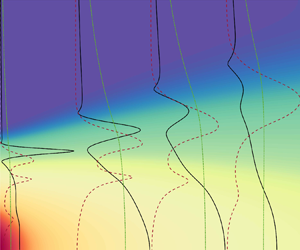Article contents
Local analysis of absolute instability in plasma jets
Published online by Cambridge University Press: 05 October 2020
Abstract

Stability features of two-stream coaxial plasma jet simulations are investigated using numerical solutions to the spatio-temporal one-dimensional linear stability theory problem. The base states obtained from magneto-hydrodynamic simulations consider the flow as a mixture of gases in local thermodynamic equilibrium (LTE) while stability computations are performed assuming both a calorically perfect gas (CPG) model and LTE. Comparisons with solutions considering a simple CPG model show the non-negligible impact of the LTE on the stability attributes of the plasma jet. For all cases studied, a large region of absolute instability is found for the axisymmetric mode, starting at the jet inlet. The streamwise evolution of the absolute growth rate is found to depend both on the baroclinic torque and the displacement of the maximum shear toward low velocity regions of the jet, combining effects described in the literature. The jet is controlled by means of electric power and static pressure at constant mass flow. The former affects mainly the absolute growth rate through changes of the core-to-bypass stream velocity ratio, while the latter influences mostly the absolute frequency. Finally, the full impulse response reveals a competition mechanism between the absolute mixed modes dominating at low group velocities, and convective shear layer modes at higher group velocities, restricted to the first half of the chamber.
JFM classification
- Type
- JFM Papers
- Information
- Copyright
- © The Author(s), 2020. Published by Cambridge University Press
References
REFERENCES
- 11
- Cited by



